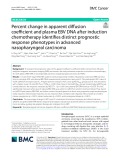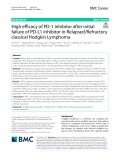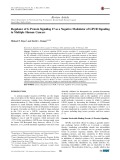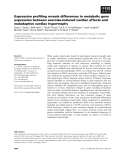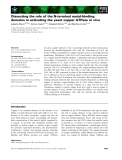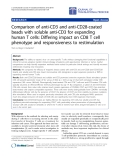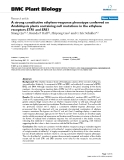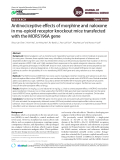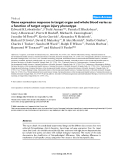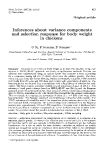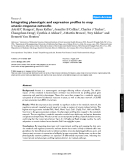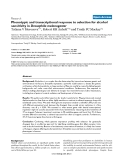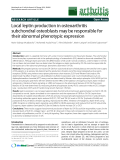
Response phenotypes
-
To evaluate the prognostic value of the apparent diffusion coefficient (ADC) derived from difusionweighted magnetic resonance imaging (MRI) and monitor the early treatment response to induction chemotherapy (IC) with plasma EBV DNA in locoregionally advanced nasopharyngeal carcinoma (LA-NPC).
 9p
9p  vielonmusk
vielonmusk
 21-01-2022
21-01-2022
 12
12
 1
1
 Download
Download
-
We sought to understand the clinical course and molecular phenotype of patients who showed disease progression after programmed cell death ligand 1 (PD-L1) inhibitor treatment but subsequently responded to PD-1 inhibitor treatment. We also explored the response to PD-1-axis targeted therapy of classical Hodgkin lymphoma (cHL) according to genetically driven PD-L1 and programmed cell death ligand 2 (PD-L2) expression.
 8p
8p  vielonmusk
vielonmusk
 21-01-2022
21-01-2022
 15
15
 1
1
 Download
Download
-
Regulators of G protein signaling (RGS) proteins modulate G protein-coupled receptor (GPCR) signaling networks by terminating signals produced by active Gα subunits. RGS17, a member of the RZ subfamily of RGS proteins, is typically only expressed in appreciable amounts in the human central nervous system, but previous works have shown that RGS17 expression is selectively upregulated in a number of malignancies, including lung, breast, prostate, and hepatocellular carcinoma.
 10p
10p  caothientrangnguyen
caothientrangnguyen
 09-05-2020
09-05-2020
 12
12
 0
0
 Download
Download
-
While cardiac hypertrophy elicited by pathological stimuli eventually leads to cardiac dysfunction, exercise-induced hypertrophy does not. This sug-gests that a beneficial hypertrophic phenotype exists. In search of an under-lying molecular substrate we used microarray technology to identify cardiac gene expression in response to exercise. Rats exercised for seven weeks on a treadmill were characterized by invasive blood pressure mea-surements and echocardiography.
 12p
12p  awards
awards
 06-04-2013
06-04-2013
 35
35
 3
3
 Download
Download
-
Two mutants ofChlamydomonas reinhardtii, mf1andmf2, characterized by a marked reduction in their phosphatidyl-glycerol content together with a complete loss in itsD 3 -trans hexadecenoic acid-containing form, also lost photosystemII (PSII) activity. Genetic analysis of crosses betweenmf2and wild-type strains shows a strict cosegregationof thePSII and lipid deficiencies, while phenotypic analysis of phototrophic revertant strains suggests that one single nuclear mutation is responsible for the pleiotropic phenotype of the mutants....
 10p
10p  dell39
dell39
 03-04-2013
03-04-2013
 51
51
 3
3
 Download
Download
-
In yeast, copper delivery to the trans-Golgi network involves interactions between the metallo-chaperone Atx1 and the N-terminus of Ccc2, the P-type ATPase responsible for copper transport acrosstrans-Golgi network membranes. Disruption of the Atx1–Ccc2 route leads to cell growth arrest in a copper-and-iron-limited medium, a phenotype allowing complementa-tion studies.
 13p
13p  vinaphone15
vinaphone15
 25-02-2013
25-02-2013
 44
44
 5
5
 Download
Download
-
Tuyển tập báo cáo các nghiên cứu khoa học quốc tế ngành hóa học dành cho các bạn yêu hóa học tham khảo đề tài: Comparison of anti-CD3 and anti-CD28-coated beads with soluble anti-CD3 for expanding human T cells: Differing impact on CD8 T cell phenotype and responsiveness to restimulation
 15p
15p  dauphong4
dauphong4
 03-01-2012
03-01-2012
 51
51
 5
5
 Download
Download
-
Tuyển tập báo cáo các nghiên cứu khoa học quốc tế ngành y học dành cho các bạn tham khảo đề tài: A strong constitutive ethylene-response phenotype conferred on Arabidopsis plants containing null mutations in the ethylene receptors ETR1 and ERS1
 15p
15p  panasonic06
panasonic06
 26-12-2011
26-12-2011
 58
58
 5
5
 Download
Download
-
Opioid analgesics such as morphine and meperidine have been used to control moderate to severe pain for many years. However, these opioids have many side effects, including the development of tolerance and dependence after long-term use, which has limited their clinical use. We previously reported that mutations in the muopioid receptors (MOR) S196L and S196A rendered them responsive to the opioid antagonist naloxone without altering the agonist phenotype. In MORS196A knock-in mice, naloxone and naltrexone were antinociceptive but did not cause tolerance or physical dependence.
 6p
6p  toshiba23
toshiba23
 18-11-2011
18-11-2011
 50
50
 1
1
 Download
Download
-
Tuyển tập các báo cáo nghiên cứu về y học được đăng trên tạp chí y học Minireview cung cấp cho các bạn kiến thức về ngành y đề tài: Gene expression response in target organ and whole blood varies as a function of target organ injury phenotype...
 0p
0p  thulanh20
thulanh20
 12-11-2011
12-11-2011
 55
55
 2
2
 Download
Download
-
Tuyển tập các báo cáo nghiên cứu về y học được đăng trên tạp chí y học Minireview cung cấp cho các bạn kiến thức về ngành y đề tài: Systematic profiling of cellular phenotypes with spotted cell microarrays reveals mating-pheromone response genes...
 9p
9p  thulanh20
thulanh20
 10-11-2011
10-11-2011
 28
28
 4
4
 Download
Download
-
Tuyển tập các báo cáo nghiên cứu về sinh học được đăng trên tạp chí sinh Original cung cấp cho các bạn kiến thức về sinh học đề tài:Phenotypic plasticity of body pigmentation in Drosophila: Inferences about variance components and selection response for body weight in chickens...
 13p
13p  toshiba19
toshiba19
 09-11-2011
09-11-2011
 52
52
 6
6
 Download
Download
-
Tuyển tập các báo cáo nghiên cứu về y học được đăng trên tạp chí y học quốc tế cung cấp cho các bạn kiến thức về ngành y đề tài: integrating phenotypic and expression profiles to map arsenic-response...
 18p
18p  thulanh19
thulanh19
 09-11-2011
09-11-2011
 41
41
 3
3
 Download
Download
-
Tuyển tập các báo cáo nghiên cứu về y học được đăng trên tạp chí y học Critical Care giúp cho các bạn có thêm kiến thức về ngành y học đề tài: Phenotypic and transcriptional response to selection for alcohol sensitivity in Drosophila melanogaster...
 15p
15p  coxanh_8
coxanh_8
 05-11-2011
05-11-2011
 44
44
 2
2
 Download
Download
-
Tuyển tập các báo cáo nghiên cứu về y học được đăng trên tạp chí y học General Psychiatry cung cấp cho các bạn kiến thức về ngành y đề tài: Local leptin production in osteoarthritis subchondral osteoblasts may be responsible for their abnormal phenotypic expression...
 13p
13p  thulanh14
thulanh14
 19-10-2011
19-10-2011
 44
44
 3
3
 Download
Download
-
Endocrine Therapy Normal breast tissue is estrogen-dependent. Both primary and metastatic breast cancer may retain this phenotype. The best means of ascertaining whether a breast cancer is hormone-dependent is through analysis of estrogen and progesterone receptor levels on the tumor. Tumors that are positive for the estrogen receptor and negative for the progesterone receptor have a response rate of ~30%. Tumors that have both receptors have a response rate approaching 70%. If neither receptor is present, the objective response rates are ...
 5p
5p  konheokonmummim
konheokonmummim
 03-12-2010
03-12-2010
 82
82
 4
4
 Download
Download
CHỦ ĐỀ BẠN MUỐN TÌM








